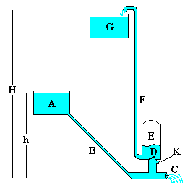Imagine a device that can move water hundreds of feet up hill, without any outside power or assistance at all. Doesn’t sound plausible does it?
Yet these things exist. They are called ram pumps. And the mystery is not how do they magically raise water to a higher level with no external power? It is, given that they are so simple, so cheap and so effective at what they do, why are they so little known?
For those who haven’t been paying attention, a ram pump is a pump that uses the force of moving water –a stream for instance, to pump a smaller amount of water, sometimes hundreds of meters uphill with no external power source.
They were invented by French scientist Joseph Michel Montgolfier two hundred and fourteen years ago. (One of the Montgolfier brothers who also invented the hot air balloon.) They have only two moving parts and astonishingly most of the ram pumps that were installed prior to 1800, are still working to this day.
Perpetual motion machines?
Green & Carter is the UK firm that first patented the device in the late eighteenth century. Not only is it still in business it guarantees its products “for ever”.
“It’s true, they just go on and on, because there’s nothing to break down” says Charles Doble managing director of Green & Carter. “Our satisfied customers include The Duke of Wellington, Thomas Jefferson, Benjamin Latrobe, the architect who designed the White House and Lawrence of Arabia, amongst many others.”
Green and Carter’s cast iron and gun metal constructions are the Rolls Royces of the ram pump world, starting at around £1000. But today there are dozens of far cheaper manufacturers offering slightly different designs and materials –or you can make your own for less than a hundred and fifty dollars.
So here we have a technology that is perfect for our times: it’s cheap, renewable, sustainable and as off-grid as you can get. It’s just the job for those who want to live the life disconnected and it’s ideal for the developing world.
Unknown miracle worker
Yet says Doble, most engineers either haven’t heard of the ram pump or don’t believe they really work. “These pumps were instrumental in developing western economies in the nineteenth century. But the moment electricity started being used to power pumps, the ram pump fell out of favour, despite being far more robust and far cheaper to run.”
It was vaguely comprehensible in the first and second world where we had the infrastructure, money and expertise to maintain powered pumps. It was inexplicable and unforgiveable that powered pumps should be preferred in the developing world, argues Doble. “In the 60s and 70’s whenever they wanted to lay on piped water to an area say in the Congo or Ethiopia, they’d send a massive, hugely expensive diesel-powered pump. Then when the diesel ran out or a part was needed, that would be the end of it.”
When the concept of appropriate technology first appeared in the 1970’s, ram pumps started to be used once more. And now people are so acutely aware of their energy consumption, the ram pump is back in vogue.
How a ram pump works
 So how does the ram pump do its magical thing of shifting water uphill with no outside assistance?
So how does the ram pump do its magical thing of shifting water uphill with no outside assistance?
The key principle is the “water hammer” effect. You may have experienced it at home when you hear a small thump in the pipes when you turn off a tap or valve quickly. This is because when water is moving at speed, it has momentum. When you stop it suddenly there is a sudden build up or ‘spike’ in pressure. It is this ‘spike’ in pressure that makes the ram pump work. (To view a ram pump in action https://www.youtube.com/watch?v=b2kv8BUVy6E)
So to use a ram pump you need a source of water with a drop to the pump. It could be a pond on a hillside or just a stream. The greater the drop and the greater the flow rate, the more powerful your pump will be. But the drop doesn’t need to be huge –three feet will do. Even a six foot drop can raise water one hundred feet or so.
The water flows into the pump over what is called a ‘pulse valve’. And this is the clever bit. As the water flows, it builds up pressure until the pulse valve slams shut. This produces a concussion –just like the thump in your taps at home when you turn them off.
The result of this concussion is that a fraction of the water in the body of the RAM is forced upwards through a second valve into an air cylinder, compressing the air in the chamber. This creates enough pressure to close the second valve. The only route for the water, which is still under high pressure, is through the outlet pipe.
One major disadvantage of the ram pump is that it wastes most of the water. Typically, only about 10% of the water it uses is actually pumped. But despite this and despite the absence of an outside power source, ram pumps are capable of transporting hundreds of gallons of water a day to a height of hundreds of feet over distances well in excess of a mile. ENDS
Auto Amazon Links: No products found.

5 Responses
Hi Everyone, is anyone still looking for RAM pumps suppliers in the US? i have an old RIFE RAM pump but it has broken – does anyone know anyone/ company who can help fix it ?
want to buy one
A PDF with a few different plans on the Ram pump. 87 pages.
https://docs.zetatalk.com/Ram_Pumps/RAM_Pump_How_To_Make_Good_Plans_2008.pdf
Try looking up Jade Mountain, they may have changed names but should be searchable.
I would like to buy a Ram pump?
No info here?